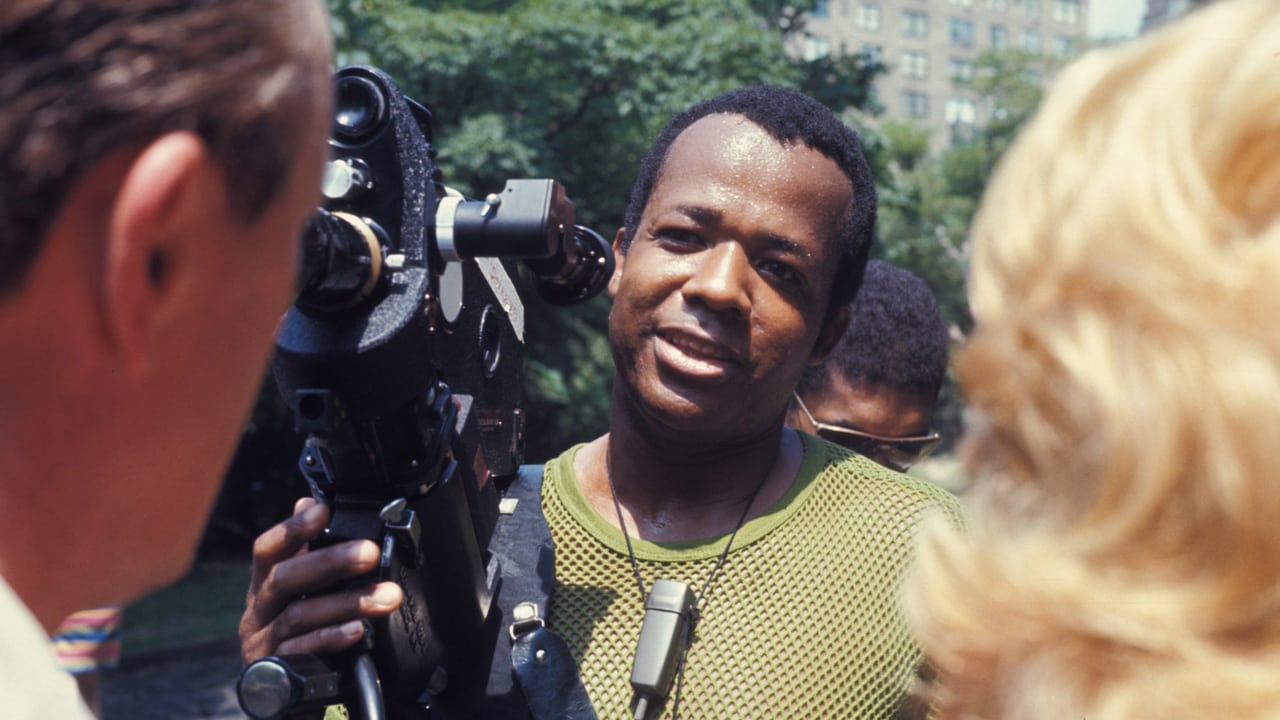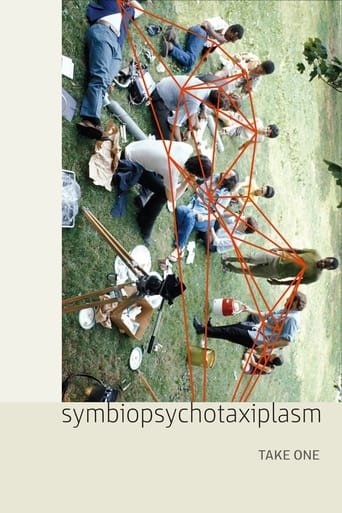

Too much of everything
... View MoreA Major Disappointment
... View MoreThis movie feels like it was made purely to piss off people who want good shows
... View MoreThis is a small, humorous movie in some ways, but it has a huge heart. What a nice experience.
... View MoreSymbiopsychotaxiplasm: Take One (1968) *** (out of 4) Incredibly fascinating little gem from director William Greaves works as a feature film but also a documentary. Basically what we have here is Greaves shooting an actual feature dealing with a husband and wife fighting about their life while walking through Central Park. That's the "feature" side of things. While they're shooting this they also have two separate cameras picking up all the drama and action going on in real life. So, the film is one where we get to see the actual feature being shot but also a documentary covering the making of the actual movie. I can't say I had ever heard of this movie before it popped up on Turner Classic Movies but part of what makes being an open-minded film buff so great is that you often come across gems that you might not have had you simply didn't expand in your viewing habits. It's really hard to explain this feature or why it works so well but I found it to be rather fascinating because there are moments where we get a third aspect of the "film" which is when the production crew are gathered in a room where they discuss where the film should go and their opinions on whether or not Greaves is doing a good job directing. These three aspects of a "film" are so interesting that you have to wonder why someone didn't try doing a picture like this a lot earlier and while there are certainly some creaky moments, overall this is a rather genius thing to try and pull off and you really can't help but applaud the director. There are some very funny moments in the behind-the-scenes section including a bit where they're filming and a group of people gather to watch and the director has to explain to them what they're doing and why they need to be quiet so that they don't ruin the scene. There are other moments where the crew fight about how much film is left, there's a sequence with a cop wanting to see some permits and then of course there's the actual film being shot, which contains a couple actors who are very good in their parts. It's also interesting to see the actors playing their parts and coming up with ideas to run past the director. I think what I really pulled away from this movie, unlike any other documentary, is how everyone working on a film thinks they're the most important part. The actors are focused on their job. The director has his job. The crew have their job and everyone is so focused on what they're doing that it's hard to really see what the other person's job is and why it might be just as important. This movie certainly isn't for everyone but those who enjoy movies about making movies should find themselves entertained.
... View MoreIn 1968 when, "SYMBIOPSYCHOTAXIPLASM: Take One", was released, it came from out of nowhere, and struck like a psychedelic thunder bolt. Afro-American actor and film maker, William Greaves, aimed to forever alter the 'news-reel' style of documentary film-making, and to this day, there has never been anything quite like it. The movie is a film about 'the making of a film', and intentionally written and directed so as to create as much controversy and contradiction as possible. Set in New York's Central Park, the action and scant dialog concern a couple who fight and bicker about homosexuality and abortion. The woman wants out of the relationship, and the man wants an explanation. Near the end of this interaction, a drunk homeless man interrupts the proceedings and offers his commentary, and personal back-story. Then, after the principle footage has been shot, the film crew add their own views of the film-maker and what they feel is his inept handling of the movie. And during the entire film, multiple cameras are employed to record the action within the scene, and extraneous commentary by cast, crew, and onlookers. I would certainly recommend this film to anyone who has an interest in Avant Garde film makers such as Andy Warhol, John Cassavetes, or Jim Jarmusch. William Greaves attempts to show that a thing cannot be truly observed and understood because the viewing itself would alter the reality. "SYMBIOPSYCHOTAXIPLASM: Take One" can be seen as a cinematic representation or application of The Uncertainty Principle. This is only one possible explanation, and Greave's true intent is certainly open for speculation. Above all else, this film seeks to confound, confront. and stimulate, and without a doubt, succeeds admirably.
... View MoreA film of high intelligence and activity. As well as being a strong capsule of the time and persona that was the 60's, the film is also TRULY a surprise in its forward-thinking themes and the unique presentation of the system of power in a group. William Greaves appoints himself to the authoritative role in the group. He asks his crew members to film and film and keep filming. First the two actors, then the crew filming the actors, then the entire set including bystanders, policemen, and finally a homeless man whose been living in bushes in Central Park for 9 weeks.Greaves edits the film (thousands of feet) together and surprisingly makes a strong narrative with an interesting arc and motivations. Don't expect to be bored by this film. Each of crew make for engaging conversationalists and often times are voicing the thoughts that the observer has watching this film. Greaves does well at integrating the multiple camera takes using synchronized three-in-one pictures and other attention shifting methods.In the end, the film will really only be effective if it's what YOU'RE looking for: if you're looking for some abstract arty film that feeds your own self-indulgent ego while never having a point, look elsewhere. If you're looking for a film that will have you talking and thinking long afterward about the desire for honesty and sincerity in documented "reality" and the inevitable transparency that comes of it, then this is the perfect film.
... View MoreI agree with the previous reviewer: it is extremely difficult to peg this film to a numerical rating. It depends on what you are looking for: if you are looking for a thought-provoking film about the performance of self, look elsewhere. Better yet, read some Erving Goffman. If, however, you want to laugh at people's ridiculous behavior before cameras, and reality television is too subtle for you, this is the perfect film.The film begins with the instantly unlikeable director, William Greaves, holding court in Central Park. He instructs the several cameramen to film each other and himself in an affected-European-accent-of-unknown-provenance (it approximates British most closely, though I am certain Greaves is a domestic product); further, that the theme of the film is "sexxxxxuality," he purrs, when he is distracted by a woman on a horse trotting them-ward. "Oh, get her! The woman with the TITS!" Awkwardly gratuitous and downright silly.This sets the tone for the rest of the film, during which two profoundly untalented actors chew their way through Greaves' painful script about the couple's married life. No cheap shock is spared, as it is revealed that she has had abortion after abortion: "one after another you've killed my babies!"; and he is a closeted homosexual: "I saw you looking at him, that fag-got that everyone knows about!" NOTE: "Take 2 1/2" (2003) includes the dramatic reunion of two other actors, also ostensibly from the desk of Greaves. The wife's character, we are informed, has been to Europe (natch.) where she has had a successful recording career. (This actress clearly went to dialog class with Greaves.) The husband has an "adopted" daughter in the music industry, who is getting mixed up in drugs. It's just like the smarmy, unctuous crew member says in the "candid" (see below): it is truly the story of every-couple USA.The best (or rather the worst) parts are the "candid" marijuana-fueled "behind-the-scenes" conversation among the crew members, who AGONIZE over the director's (quite transparent) intentions; the "meaning" of the film; the "authenticity" of the experience, etc. Many complain about the abysmal writing. Greaves later confronts the mutineers on the set, where his initial defensiveness gives way to self-satisfaction: apparently this was the whole idea! It's SUPPOSED to be bad! The really remarkable thing, as far as I'm concerned, is that the director, actors and crew apparently saw the film and released it anyway. Not only is it awful beyond awful, it makes them all look like pretentious, self-indulgent and woefully inept art-school weasels. Every line made me laugh through gritted teeth.
... View More